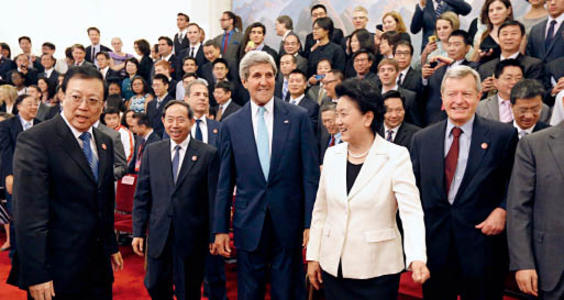Dialogue Mechanism Leads to New Sino-U.S. Relations
 |
|
Chinese Vice Premier Liu Yandong and U.S. Secretary of State John Kerry co-chair the plenary meeting of the 2014 CPE. |
Vice Premier Liu Yandong looked back on the numerous fruits of the CPE over the past five years. Thirteen deals in four fields were struck in the first round of the Consultation, which has now extended to 104 deals in six fields. Among the areas discussed are education, science and technology, culture, sports, women and youth. Nearly 200 deals have been reached over the five years. So far the two countries have more than 240 pairs of sister provinces/states and cities, and operate a number of exchange mechanisms including the China-U.S. Governors Forum and several economic summits.
Student exchanges have enhanced understanding between students and peoples in the two countries. Trough the Triple 10,000 Plan, China promised to invite 10,000 American students to study in China, invite 10,000 American visitors through the Chinese Bridge program, and send 10,000 Chinese PhD students to study in the U.S. The USA’s 100,000 Strong Initiative represents a similar commitment from the American government. As Abraham Lincoln once said, “Nothing valuable can be lost by taking time.” A 2013 Gallup survey found that 72 percent of Americans aged 18-29 regard China an ally or friend.
People-to-people exchanges are the vanguard and trailblazer in China-U.S. relations, and hence serve as the lubricant in the new model of major power relationship between the two countries. To this end China and the U.S. should respect each other, cultivate the concept of equality and inclusiveness among their peoples, and carry out pragmatic cooperation to lay a solid foundation for their future relations. They must make persistent efforts to jointly foster a future of peace and development.
In 2009, the establishment of diplomatic relations between the two countries passed the 30-year mark, the “age of independence” for a man in China. As it approaches 40, the “age of reason,” arguments remain heated and it is unclear whether the two countries are moving towards a brighter or a darker future. Whether they will be friends or foes, with peace or conflict, remains under debate. The division between the pros and cons is broad. The questions don’t stop here. In which direction should China and the U.S. move their relationship? Is the current cooperation meaningful and conducive to shared goals? The world needs clear-cut answers for these critical questions, which are not easy to come by. As the old Chinese maxim says, it is easier to speak than to act.
Henry Kissinger wrote in his recent book: “I am aware that the cultural, historical, and strategic gaps in perception that I have described will pose formidable challenges for even the best-intentioned and most farsighted leadership on both sides. On the other hand, every great achievement was a vision before it became a reality.” This is relevant to the new model of major power relations which China and the U.S. are working on. High-level communication channels like the S&ED and the CPE are stepping stones which will create a path for the Sino-U.S. relations to move forward.
